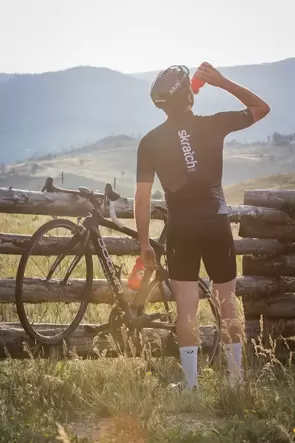Allen Lim, PhDSponsor Post - Article provided by Pikes Peak Marathon partner, Skratch Labs  One thing to realize is that in the heat a high sweat rate can easily amount to a 2 liters of fluid loss per hour. Know that at even a 2-3% drop in body weight due to dehydration, our performance can suffer and that by the time we reach a 5% loss, many people can be in a bad place. If you want to learn more on hydration science basics check this out. One of the easiest ways to get at your sweat rate is to use a scale to weigh yourself before and after a workout. Any weight loss (where 1 lb is equal to 16 oz of water) plus the amount of fluid consumed while working out is your total sweat loss. That said, if you're gaining weight over the course of a workout, then you are drinking too much. Ideally, try not to lose more than 3% of your body weight from dehydration. An important consideration, however, is that rehydration during exercise isn't just about water balance, it's also about sodium balance. What this means is that to adequately hydrate, you need to replace both the water and the sodium that you lose during exercise. Unfortunately, sweat sodium is highly individual and can vary anywhere from 400 mg to 2000 mg per liter of sweat, with an average somewhere between 700-900 mg per liter (Skratch Sport Hydration is 800 mg per liter). As a general rule of thumb, if you're not consuming enough salt relative to water, you'll find yourself needing to urinate frequently despite losing body weight due to sweat loss. On the other hand, if you're consuming too much salt relative to water, you'll find yourself wanting to drink more water and potentially gaining weight as the high salt intake might drive you to drink at a greater rate than your sweat loss. Remember, hydration is about 2 needs:
So ... drink to thirst with Sport Hydration Mix while you are working out or racing and if you are underweight after your workout/race add more salt. This could be preloading with our Wellness Hydration Drink Mix or Hyper Hydration Drink Mix, or it could be testing using 1.5 scoops of Skratch per 16 ounces instead. It's generally not the dehydration, in and of itself, that is as much of a problem as the change or increase in body temperature that comes with it. Even if you were properly hydrated, if you get too hot for too long, the heat strain in and of itself can create the symptoms of headache and woe that you experienced. In fact, when I was the sport science director at Garmin and Radio Shack one of our most important priorities immediately after a race in the heat was to bring down core temperature as quickly as possible. We used a combination of cold showers, ice bath dunks, slushies, and cooling vests to do so. What we learned was that as long as body temperature stayed elevated post exercise, the athletes remained in a catabolic state making it impossible to recover or sleep. Another trick we used with the pros for hot training days was to have them head out with knee high panty hose and a rubber band in their back pocket. When it got really hot, they would stop in a gas station and fill the panty hose with ice and close them off with the rubber band. They'd then wrap the ice-filled sock around their necks or just put it down the back of their jersey to help them stay cool on very hot days. We use these same ice socks during hot races and they are often a critical performance factor. Finally, know that at high sweat rates, people tend to lose more sodium in their sweat. In these situations, it may not be enough to just drink a single serving of Hyper before hot training days. Many athletes we work with find that up to a liter of Hyper before is more effective for them. In addition, many will drink a full serving of Hyper in the middle of their ride for their longer (4-5 hours) rides to help replace their sodium loss. Long story short, if you're going to go out in the heat, just know that preparing yourself for the conditions may just take a lot more fluid, salt, and cooling tricks than cooler days, especially if it's humid out and sweating becomes a less effective means of cooling. In addition, after you get done, the first thing to try and do is weigh yourself, drink to the loss, satiate any craving for salt, and cool yourself quickly. Comments are closed.
|
©
Pikes Peak Marathon

